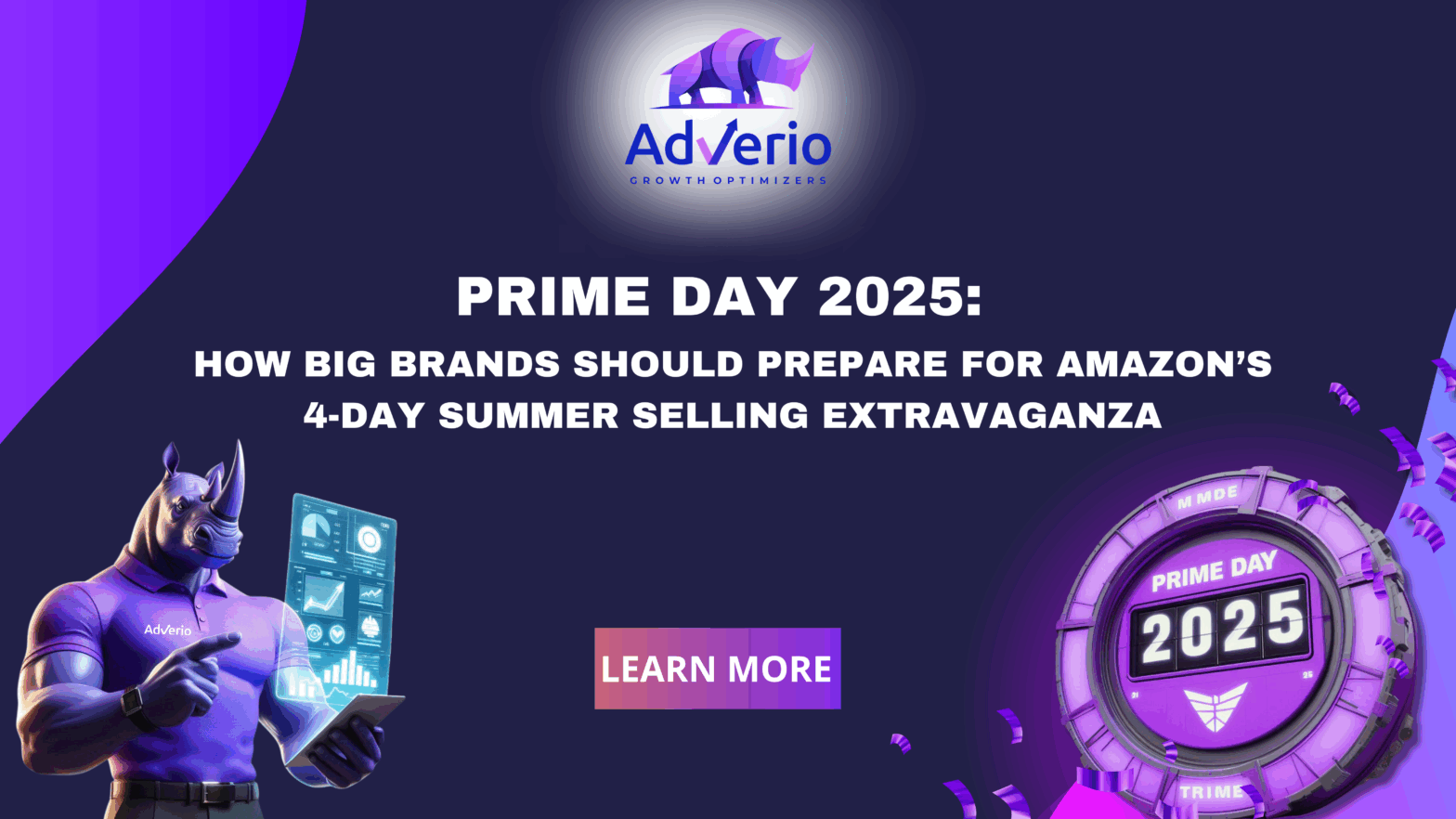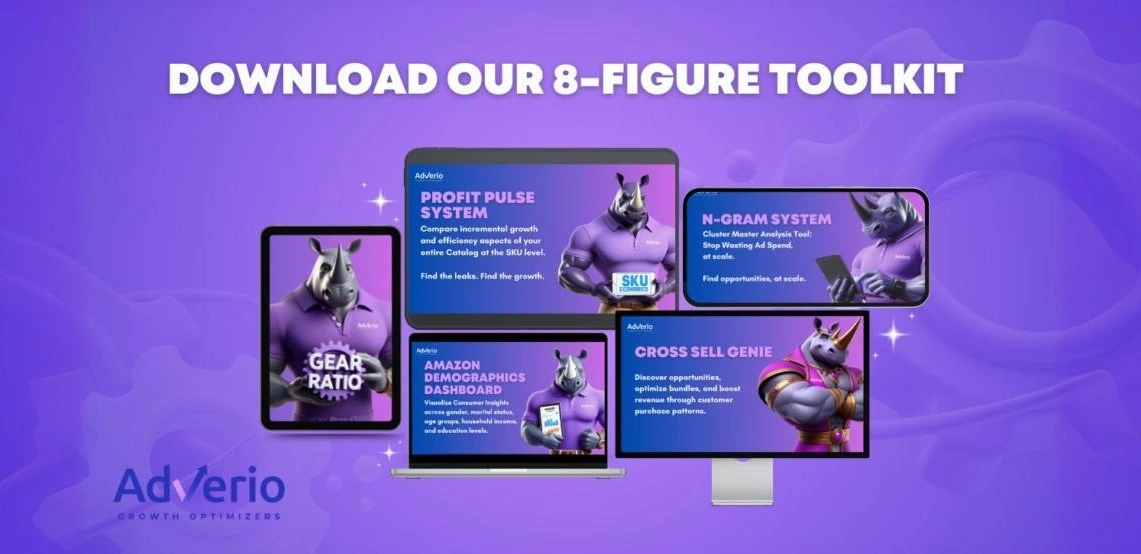Table of Contents
Prime Day has become an all-out mid-summer battlefield on Amazon. Last year, independent sellers sold over 200 million items in 48 hours during Prime Day. This year, Amazon is upping the ante with a 4-day Prime Day extravaganza.
For established brands like yours (mid-7 to mid-8 figure revenue, hundreds to thousands of SKUs), that means more opportunity, and more pressure. This isn’t your first rodeo, so let’s cut the fluff and get straight to what matters.
Mark Your Calendar: Key Dates You Can’t Afford to Miss
When it comes to Prime Day prep, timing is everything. Amazon doesn’t give extensions, so missing a deadline isn’t an option. Lock these dates in now (set alarms, poke your ops team, whatever it takes):
- May 15, 2025 – AWD Inventory Deadline: If you use Amazon Warehousing & Distribution (AWD), get inventory in by this date to ensure it’s Prime-ready with the Prime badge on Day 1. AWD lets Amazon hold your excess stock and feed it into FBA as needed.
Miss this deadline, and that stock might not carry the Prime badge (translation: you’ll lose the conversion-boosting Prime promise during the event). For brands guarding the Buy Box, this is non-negotiable. - June 2nd, 2025 – Final Day to Submit Prime Day Deals: This is the drop-dead date to schedule Lightning Deals & Prime Best Deals (Amazon opened deal submissions back on March 18; hope you started early.) By June 2nd, every deal you want featured must be submitted and tagged for Prime Day.
Pro tip: If you missed setting up Lightning or Best Deals, you can still submit Prime Exclusive Price Discounts up to and throughout the Prime Day window. When setting a Prime Exclusive Discount, check that “Prime Day” box – without the official Prime Day badge, your offer won’t get the exposure it deserves (the badge can boost sales up to 5.5× vs. unbadged offers!). - June 9, 2025 – FBA Inventory Cutoff (Minimal Split Shipments): Ensure your product shipments arrive at Amazon by June 9 if you want your inventory Prime Badge guaranteed.
Hitting this date means Amazon will try to keep your stock in fewer fulfillment centers, speeding up check-in. For you, that means less risk of inventory getting stuck in transfer when the Prime Day floodgates open. - June 18, 2025 – FBA Final Inventory Deadline (Optimized Split Shipments): This is the absolute last call for FBA inventory to be checked in for Prime Day.In order to guarantee Prime fulfillment, shipments arriving after June 10th and up to June 18th will be required to be split across warehouses (Amazon’s “optimized split shipment” option).
After the 18th, all bets are off, inventory that isn’t fully received by this date may not be available during Prime Day even if you submitted deals. In other words, blow this one and your Prime Day plans could go up in smoke.
Bottom line: Working backwards from these dates is now your team’s religion. Give yourself buffer room for hiccups (logistics never sleep). As Amazon likes to remind sellers, “plan early and lock in everything you can”. Prime Day is a game of preparation, and the timer has been set.
Double Down on Deals: Lightning, Best, Exclusives, Coupons
Big brands don’t win Prime Day just by showing up; you win by working the system. That means leveraging Amazon’s deal types to the fullest. By now you’ve probably experimented with them all, but here’s a no-nonsense refresher on each Prime Day promotion (and how a mature seller should use them):
- Prime-Exclusive Lightning Deals: Time-sensitive flash deals that run for a few hours with a steep discount ($20% off). They cost a hefty fee (around $500 per deal for Prime Day), worth it if you need to create urgency, boost rank, or clear a glut of inventory fast.
Use Lightning Deals to make a splash on high-visibility ASINs or to blitz competitors in your category for a few hours. Just be selective; that fee and margin cut mean these are for your potential blockbusters or strategic plays only. - Prime-Exclusive Best Deals: Longer promotions spanning the entire Prime Day event (yes, all 4 days) with at least 15% off.These come with an even bigger fee (~$1,000 each), so reserve Best Deals for your proven winners, the products you know will convert like crazy if they get the spotlight.
Best Deals get premium placement (Deals page, possible homepage banners) and are perfect for top sellers that can justify the spend. Think of it as paying for front-of-store placement on the biggest shopping days of the year. - Prime-Exclusive Discounts (PEDs): Essentially a Prime-member-only sale price on your ASINs. Minimum 15% off to qualify and a negligible fee (~$100 covering up to 500 SKUs).
These are the workhorses for Prime Day: lower cost, easy to scale across many products, and they still display a Prime Day deal badge on your listing if properly set.
Use PEDs on products that didn’t get Lightning or Best Deals, or to broadly discount your catalog for Prime members. It’s a great way to blanket your store with “Prime Day” offers without breaking the bank. Just remember that Prime Day badge trick, tag them right to get that conversion-boosting badge. - Prime Member Coupons: Those little green coupons on Amazon that Prime members can clip for extra savings. They only require 5%+ off and you pay a fee ($5 per coupon setup plus 2.5% of sales).
Lower lift, lower visibility, coupons appear on the product page, in search results, and on the Coupons page, but they’re not as attention-grabbing as the big deals.
However, they’re super flexible: you can set them up last-minute, target them to specific products or bundles, and even stack them on top of other deals for extra oomph. Use coupons as a safety net, if an ASIN isn’t eligible for other promos or you want a modest discount to entice on-the-fence shoppers, throw a coupon on it.
Best practice for pros: submit those deals early (again, June 2nd cutoff for Lightning/Best Deals) and double-check eligibility. Ensure your deals meet Amazon’s criteria (discount %, seller rating, sales history, etc.) and make sure your pricing math pencils out. It’s easy to get swept up in the “bigger discount = more sales” logic and forget your margins.
Bake in Amazon’s referral fees, FBA fees, deal fees, and the impact of the discount. The most savvy operators set floor prices or use pricing tools to avoid any money-losers. Also, have a fallback: if a deal doesn’t get approved or you miss the window, be ready to pivot that ASIN to a Prime Exclusive Discount or Coupon so every key product has a Prime Day offer in some form.
Inventory: Don’t Stock Out, Don’t Slow Down (Use Every Trick in the Book)
Imagine running a killer Lightning Deal on Day 2 only to stock out by Day 3, nightmare. Inventory planning is the unsexy hero of Prime Day success. As an experienced brand, you know your demand patterns, but Prime Day 2025’s extended length means rethinking the volumes. Here’s how to stay ahead:
- Forecast and Over-forecast: Dive into last year’s Prime Day sales data and Q2 trends to project demand by SKU. Then add a buffer, many pros plan 4+ weeks of extra stock for Prime Day just in case.|
With 4 days of deals (double the usual event length), err on the side of too much inventory. Worst case, you’ll have leftovers for the post-Prime Day bump (there’s often a halo effect). Running dry in the middle of Prime Day means lost sales you can’t get back, avoid at all costs. - Mind Your FBA Capacity: Check your Amazon Inventory Performance Index (IPI) and FBA storage limits now. High-volume brands often dance on the edge of those limits. Use Amazon’s Capacity Monitor and Manager tools to see how much space you have and request more if needed.
Nothing worse than wanting to send 10,000 units and Amazon says “no room at the inn.” If you’re bumping up against limits, act early, increase sell-through on stagnant SKUs, negotiate extra space, or use a 3PL as backup. - Leverage AWD for Overflow: Amazon Warehousing & Distribution (AWD) is your secret weapon for Prime Day stock. You can forward-position inventory in Amazon’s new warehouses so it’s ready to inject into FBA when needed, without eating up your FBA quotas.
For example, ship a big chunk to AWD in advance; Amazon will hold it and automatically replenish your FBA stock throughout the event. Just remember the May 15 cutoff for AWD to guarantee those units are Prime-eligible. AWD isn’t cheap, but compared to missed sales, it’s a no-brainer insurance policy for high performers. - Backup Plans for Replenishment: If you manage your own logistics, have a rapid response plan. Can you expedite a refill to FBA mid-event if something blows up in popularity? It’s tough (thanks, cutoffs), but maybe you can fulfill via FBM (Merchant Fulfilled) as a stopgap if you at least have stock in your own warehouse.
Ensure your 3PL or warehouse is on standby and watching sales closely. Every hour of Prime Day counts, so agility is key. - Ship Early and Track Relentlessly: And of course, by now all your Prime Day-bound shipments should been route or ready to leave. Use Amazon partnered carriers or Amazon Freight and ship well ahead of deadlines.
Track those shipments like a hawk; if something gets stuck in transit or processing, raise hell with Amazon support before the event starts. Your inventory is the fuel for the Prime Day fire, don’t let it run out.
Make Your Listings Conversion Machines
You’re driving a tidal wave of traffic to your listings during Prime Day, but traffic means nothing if the listings don’t convert. Prime members are ready to spend, but they’re also comparing like crazy.
This is no time for sloppy listings. Take a hard look at your product detail pages now, with an eye for anything that could cost you a sale:
- Polish Titles and Bullets: Your product title and bullet points should hit key keywords and unique value props clearly. Cut any fluff or outdated info.
These shoppers are skimming search results at lightning speed, so make sure your title immediately communicates what the product is and any Prime Day deal (“Bundle – 20% off Prime Day” or a keyword like “Prime Day Deal” can be title-worthy if allowed). Bullets should be concise and benefit-driven. A no-nonsense tone works here too, tell them why your product rocks and why now is the time to buy. - Refresh Images & A+ Content: High-quality images are mandatory. By now you likely have professional photos, but double-check compliance (no random text or logos that could get the listing suppressed).Add an image highlighting the product in use or showing what’s in the box if it helps conversion.
If you have A+ Content or a Brand Story section, optimize it with a Prime Day twist, for example, a banner that says “Prime Day Sale” or highlights an offer can create urgency. Rich content should reinforce trust (think quality badges, comparison charts, lifestyle images). Make shoppers feel they’re getting a premium product at a steal. - Audit Reviews and QA: Savvy shoppers read reviews. Ensure you’ve addressed any recurring complaints in your listing copy or via recent product improvements.If you’ve got thousands of reviews with a 4.5★ average, flaunt it subtly (“Join 10,000+ happy customers” in a bullet).
Also, check the Q&A section on your listing, if important questions are unanswered, answer them now. A well-informed customer is one step closer to checkout. - Eliminate Conversion Killers: Most importantly, remove any conversion killers: fix that stray typo, update that old size chart, or remove that unfulfillable variant.In Prime Day’s frenzy, shoppers won’t give you a second chance.
Many top brands even do a quick listing audit in the week before, sometimes an external expert (hello, Adverio 😉) can spot things your team overlooked. It’s all about sweating the details now so you’re not sweating lost sales later.
Amp Up Your Advertising (Strategically)
Prime Day is a feeding frenzy, and ads are how you ensure your bait gets taken. With bigger brands pouring cash into Amazon Ads, you need a smart plan, not just a big budget. Here’s how seasoned advertisers play it:
- Ramp Budgets Beforehand: Don’t wait until July to turn on the jets. In the week leading up to Prime Day, start increasing budgets and bids on your evergreen campaigns. Why?
Shoppers are already Browse and research mode kicks in early. You want to capture those early birds and, crucially, juice your sales velocity so Amazon’s algorithm favors your products when Prime Day starts. By Prime Day, your campaigns should be running hot, not warming up. - Isolate Your Prime Day Deals in Campaigns: If you’re running big promotions on certain ASINs, give them dedicated ad campaigns. This way you can pour fuel on those specific items without the budget being eaten by other products. Create Sponsored Product campaigns targeting keywords and competitors relevant to those hero deals.
Also, set up Sponsored Brands ads featuring a custom Prime Day headline (“Prime Day Deal – 30% Off [Brand]”) to grab attention.Segmentation is key, treat your deal ASINs like the VIPs they are for these 4 days. - Offense and Defense with Keywords: Bid on competitor terms and category keywords aggressively during Prime Day. Your rivals will be doing the same, so don’t let them steal your thunder on search results.
At the same time, protect your turf, run defensive campaigns on your brand name and product names so deal-hunters looking you up don’t get lured away by another sponsored result. Consider using Sponsored Display or DSP to retarget anyone who viewed your product in the lead-up, Prime Day is the time to bring them back with a deal. - Watch Ads Like a Hawk: The PPC landscape shifts by the hour during Prime Day.
Assign someone on your team (or your agency) to monitor campaign performance closely.Be ready to adjust bids in real-time if a keyword is on fire or to reallocate budget if one campaign is crushing it and another is underperforming. Amazon will happily take your money, but we want ROI.
Set up alerts or just live in the ad console for those 4 days. This is where a partner like Adverio’s Amazon Ads team can be clutch, we’ve got eyes on campaigns 24/7 so you don’t have to panic-check every hour.
Remember, advertising and organic efforts work hand-in-hand. A well-timed ad can kickstart momentum for a deal, which then boosts organic rankings and visibility in the middle of Prime Day.
Play the long game (think beyond ACOS for those days, consider the tail effect on your sales rank post-event).
Final Prep: Hype, Contingencies, and a Little Luck
You’ve nailed the deadlines, set up killer deals, padded your inventory, polished listings, and lined up an ad blitz. What’s left? Just a few last touches seasoned brands know to add:
- Generate Pre-Event Buzz: Use your brand’s email list and social channels to build anticipation. A week or so before Prime Day, drop hints to your followers that something big is coming.
On Prime Day itself, consider sending a newsletter highlighting your top deals (timed with when those deals go live). Likewise, coordinate with any influencers or partners to mention your Prime deals. The idea is to send ready-to-buy traffic to Amazon when the event kicks off. - Get Your Team in “War Room” Mode: Prime Day is all-hands-on-deck. Ensure your customer service team is staffed and ready, fast responses to any issues (like listing suspensions, unexpected negative reviews, or buy box hijackers) can save your bacon.
Keep your operations team on call in case a last-minute fulfillment issue pops up on Walmart or Target (yes, those marketplaces often run parallel promotions, you don’t want to neglect them either). Have a clear internal comms channel for Prime Day where everyone sees sales updates, issues, and victories in real time. - Plan for Post-Prime Day: A pro thinks beyond the event. If you sell out of a hero product, how will you capitalize on that momentum (back-orders? a waitlist with a coupon for later?).If you collected a ton of new customers, how will you re-engage them?
Line up a review request strategy for the surge of orders (Amazon’s Vine or automated review requests can help keep that feedback loop going). - Monitor Competitors Post-Event: Also, be ready for competitors to drop prices right after Prime Day to catch anyone who missed out, don’t get caught flat-footed.
Finally, take a deep breath. Once Prime Day begins, it’s showtime. As one Amazon veteran put it, “there’s not much you can do but ride the wave.”
If you’ve prepared like the insider you are, you’ll do more than just ride, you’ll own it. And remember, you don’t have to do it alone.
Whether it’s inventory planning, Amazon ads, or conversion optimization, the team at Adverio lives for this stuff. We’ve been in the trenches with brands like yours, and we’re here to ensure Prime Day 2025 is your biggest win yet. Good luck and happy selling!





























